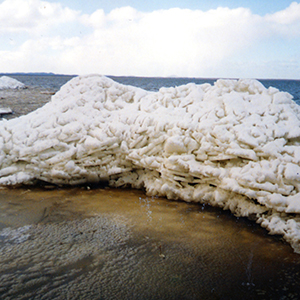Relationships between air temperature and ice conditions on the southern Baltic coastal lakes in the context of climate change

Accepted: 18 March 2022
HTML: 118
All claims expressed in this article are solely those of the authors and do not necessarily represent those of their affiliated organizations, or those of the publisher, the editors and the reviewers. Any product that may be evaluated in this article or claim that may be made by its manufacturer is not guaranteed or endorsed by the publisher.
Authors
Shallow, lagoonal coastal lakes of the Southern Baltic are exceptionally susceptible to atmospheric factors. This work examines the influence of winter air temperatures in Ustka on ice parameters (dates of first ice occurrence and last ice disappearance, ice season duration, number of days with ice, and maximum ice thickness) on Southern Baltic coastal lakes (Jamno, Bukowo, Gardno, Łebsko), and trends displayed by changes in these parameters over the period spanning 1960/61-2019/20. The research data was retrieved from the archives of Institute of Meteorology and Water Management – National Research Institute. As a first step of the analysis, we investigated the statistical relationships in spatial and temporal variations in winter air temperature and coastal lake ice parameters. Correlation and regression method was employed to determine the influence of air temperature on coastal lake ice conditions. Correlation and determination coefficients were calculated, and linear regression equations were determined. The statistical significance of the observed relationships was assessed using Fisher-Snedecor test. Additionally, linear trend models were constructed. Our analysis indicates that from 1960/61 to 2019/20, the average rate of increase in winter temperature (December-March) in Ustka equalled 0.04°C ⋅year-1. The correlation coefficients for air temperature versus ice parameters were highly statistically significant (p<0.001). The strongest relationships (with correlation coefficients below -0.90) occurred between air temperature and number of days with ice. Ice season duration and number of days with ice are both closely linked with last ice disappearance date and ice thickness. Our analysis shows that a 1°C increase in average seasonal air temperature will result in the number of days with ice on the studied coastal lakes becoming reduced by 16-17 days. All trends in ice parameters indicate a mildening of ice conditions. Most of the assessed trends are statistically significant. The strongest trends were observed for ice season duration, and indicate its shortening toward the east, from 0.66 day ⋅year-1 (Lake Jamno) to 1.16 day ⋅year-1 (Lake Łebsko). All correlation coefficients for ice trends were found to increase eastward, which could be explained by an increasing influence of the warming climate over the Southern Baltic in this direction. The strong relationships between air temperature and Southern Baltic coastal lake ice parameters, and the determined rate of changes may have a significance for forecasting, as the shifting dates of ice formation and disappearance on lakes are highly important for the lake hydrodynamics, and the functioning of aquatic ecosystems.
Edited by
Michela Rogora, CNR-IRSA Water Research Institute, Verbania, ItalySupporting Agencies
Institute of Marine and Environmental Sciences, University of Szczecin, Poland, Institute of Meteorology and Water Management - National Research Institute, PolandHow to Cite

This work is licensed under a Creative Commons Attribution-NonCommercial 4.0 International License.
Similar Articles
- Claudia Dresti, Andrea Fenocchi, Diego Copetti, Modelling physical and ecological processes in medium-to-large deep European perialpine lakes: a review , Journal of Limnology: Vol. 80 No. 3 (2021): Celebratory Issue - 80th Anniversary of the Journal of Limnology
You may also start an advanced similarity search for this article.

 https://doi.org/10.4081/jlimnol.2022.2060
https://doi.org/10.4081/jlimnol.2022.2060




